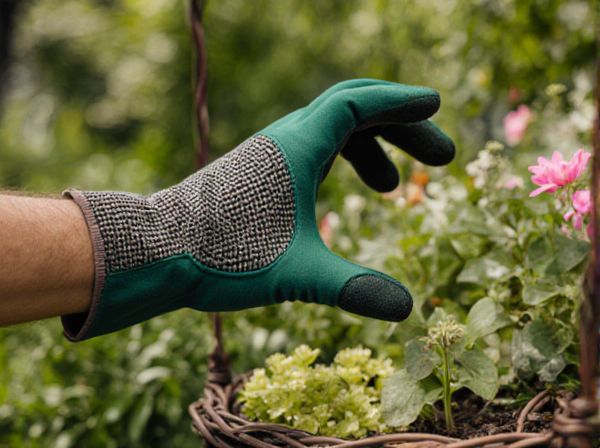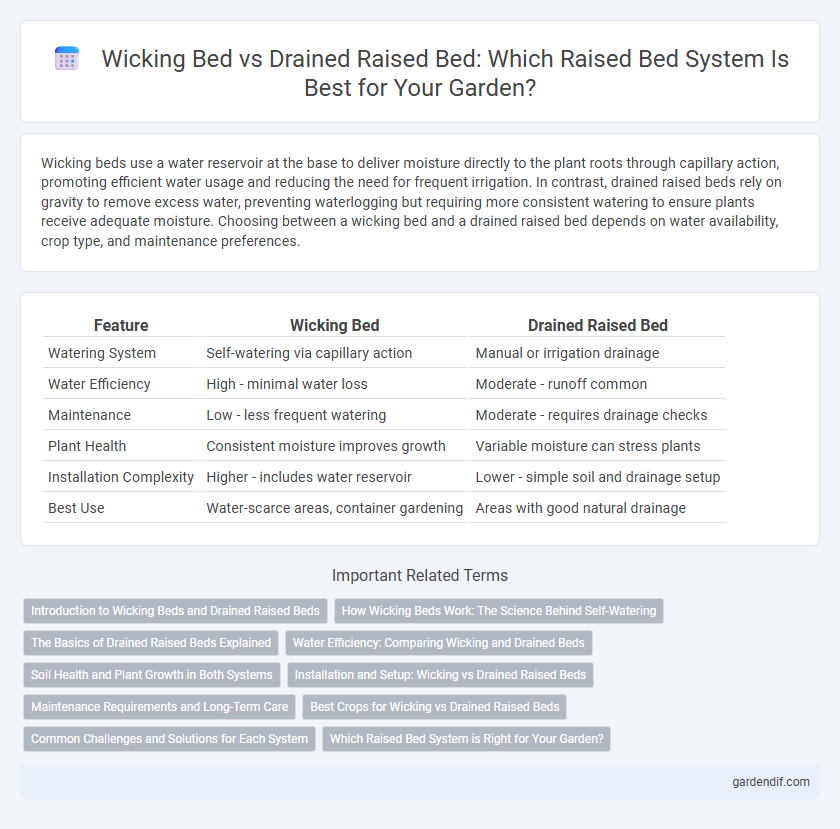
Wicking Bed vs Drained Raised Bed Illustration
Wicking beds use a water reservoir at the base to deliver moisture directly to the plant roots through capillary action, promoting efficient water usage and reducing the need for frequent irrigation. In contrast, drained raised beds rely on gravity to remove excess water, preventing waterlogging but requiring more consistent watering to ensure plants receive adequate moisture. Choosing between a wicking bed and a drained raised bed depends on water availability, crop type, and maintenance preferences.
Table of Comparison
| Feature | Wicking Bed | Drained Raised Bed |
|---|---|---|
| Watering System | Self-watering via capillary action | Manual or irrigation drainage |
| Water Efficiency | High - minimal water loss | Moderate - runoff common |
| Maintenance | Low - less frequent watering | Moderate - requires drainage checks |
| Plant Health | Consistent moisture improves growth | Variable moisture can stress plants |
| Installation Complexity | Higher - includes water reservoir | Lower - simple soil and drainage setup |
| Best Use | Water-scarce areas, container gardening | Areas with good natural drainage |
Introduction to Wicking Beds and Drained Raised Beds
Wicking beds are self-watering garden beds that use a water reservoir beneath the soil to provide consistent moisture through capillary action, reducing water usage and promoting healthy plant growth. Drained raised beds feature soil contained above ground level with drainage systems that prevent waterlogging, ensuring optimal aeration and root health. Both methods enhance soil management, with wicking beds emphasizing water efficiency and drained raised beds focusing on effective drainage and soil structure.
How Wicking Beds Work: The Science Behind Self-Watering
Wicking beds operate on the principle of capillary action, drawing water upward from a reservoir below through a permeable barrier directly to plant roots, ensuring consistent moisture levels. This self-watering system reduces water waste and promotes healthy root development by providing plants with optimal hydration without over-saturation. In contrast to drained raised beds, wicking beds maintain a stable water supply, minimizing the need for frequent watering and improving overall plant growth efficiency.
The Basics of Drained Raised Beds Explained
Drained raised beds are designed with a bottom layer of gravel or coarse material to facilitate excess water drainage, preventing waterlogging and root rot. These beds promote healthy root development by ensuring adequate oxygen availability and preventing soil saturation. Unlike wicking beds, drained raised beds rely on gravity for water removal rather than a reservoir system.
Water Efficiency: Comparing Wicking and Drained Beds
Wicking beds maximize water efficiency by delivering moisture directly to plant roots through a saturated reservoir, reducing evaporation and runoff. Drained raised beds rely on surface watering, which often results in higher water loss due to drainage and evaporation. Studies show wicking beds can use up to 50% less water while maintaining consistent soil moisture levels essential for healthy plant growth.
Soil Health and Plant Growth in Both Systems
Wicking beds maintain consistent moisture by drawing water upward from a reservoir, promoting healthy microbial activity and reducing soil erosion, which enhances root development and nutrient uptake. Drained raised beds prevent waterlogging through efficient drainage, supporting aerobic soil conditions essential for beneficial organisms and preventing root rot. Both systems improve soil structure and plant growth, but wicking beds excel in water conservation while drained beds optimize oxygen availability for roots.
Installation and Setup: Wicking vs Drained Raised Beds
Wicking beds require a sealed water reservoir beneath the soil, demanding precise layering of a waterproof liner, gravel, and soil to enable capillary action for consistent moisture delivery. Drained raised beds need proper drainage systems such as bottom drilling or installation of drainage pipes to prevent waterlogging and ensure excess water exits effectively. Installation of wicking beds is more complex due to the need for water retention components, while drained beds prioritize efficient water runoff to maintain optimal root aeration.
Maintenance Requirements and Long-Term Care
Wicking beds require minimal maintenance due to their self-watering system that reduces frequent irrigation and helps maintain consistent soil moisture levels, preventing plant stress. Drained raised beds need regular watering and careful drainage management to avoid waterlogging and root rot, increasing long-term care efforts. Over time, wicking beds benefit from periodic checks on the water reservoir and refill, while drained beds require ongoing soil aeration and monitoring to sustain healthy plant growth.
Best Crops for Wicking vs Drained Raised Beds
Wicking beds excel at growing moisture-loving crops such as tomatoes, cucumbers, lettuce, and herbs due to their consistent water supply from below. Drained raised beds are better suited for plants requiring well-drained soil, like carrots, onions, potatoes, and root vegetables, which thrive without waterlogged conditions. Selecting the right raised bed type optimizes crop yield by matching soil moisture levels to specific plant water needs.
Common Challenges and Solutions for Each System
Wicking beds often face challenges of overwatering and root rot, which can be mitigated by installing proper drainage systems and using soil moisture sensors to monitor irrigation levels. Drained raised beds commonly experience water stress due to rapid drainage and nutrient leaching, but these issues can be addressed by incorporating organic mulches and slow-release fertilizers to retain moisture and nutrients. Both systems benefit from selecting suitable soil mixes that balance water retention and aeration to promote healthy plant growth.
Which Raised Bed System is Right for Your Garden?
Wicking beds offer a self-watering system that conserves water by allowing plants to draw moisture from a reservoir below, ideal for drought-prone areas and low-maintenance gardening. Drained raised beds provide superior drainage and soil aeration, reducing root rot and making them suitable for heavy or clay soils prone to waterlogging. Choosing between a wicking bed and a drained raised bed depends on your garden's climate, soil type, and watering needs for optimal plant growth.
Wicking Bed vs Drained Raised Bed Infographic

 gardendif.com
gardendif.com